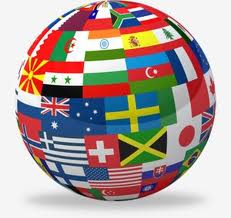 This is the first of a 2 part series. Go on to Part 2, which contains a listing of Ethical Fashion events, trade fairs, and designer directories.
This is the first of a 2 part series. Go on to Part 2, which contains a listing of Ethical Fashion events, trade fairs, and designer directories.
This autumn’s possibly main lessons (call it surprise, shock, insight) for me was the realisation to which degree national borders segregate markets, the industry, people in the industry, and market awareness. Surprising considering that we’re in the 21st century and the term ‘globalisation’ more often than not falls in any arbitrary coffee cup conversation.
Or is it languages that create segregation, rather than the borders themselves?
(Side note: In which case, for instance, Irish and UK English would need to be classified as different languages …)
Either way, in the end, the result is pretty much the same:
One goes from LFW’s EstEthica to Paris’ Ethical Fashion Show only to realise that in fact, most of the brands in Paris are as knowledgeable about the products, product strategies and production practices of their national peers, as they are ignorant about what is happening abroad. You’d be, of course, equally hard pressed to have a substantial conversation about French ethical brands at EstEthica.
Broaden the scope to include, say, Germany in the equation – a strong hold of ‘green’ policies within the European Union, and home to Hess Natur, an ethical online fashion retailer with a whooping 70 Mio. Euro ($110 Mio. turn over) – and the outcome is even more depressing. Add the Scandinavian countries – another innovative geographical area in ethical fashion terms – and the lack of knowledge is just plainly overwhelming. Globalisation anyone?
What I claim in this blog post is, of course, fairly valid for just about all areas of sustainability, certainly in textiles and apparel. Public policies are to an important degree traceable through press releases, official statements of EU entities or research bodies, and there is some serious research taking place on this level (e.g. Mark Starmanns from the University of Zurich, Switzerland, and Doug Miller at Northumbria University’s Centre for Design Research).
The same does though not apply to what is happening in the market place. Primarily because ethical/sustainable brands and makers are in reality still very much a minority, and the brands are having a hard time to shape the market, the terms of competition, and last but not least the public perception, in their favour.
Few are the people that know, or at least have a valid idea, of what is going on on a European level – not to mention the Americas or the Asia-Pacific. And even fewer, if any, belong to the category of running their own brand.
This all said, in the upcoming blog post, I’ll contribute my 2-pence worth to improve the situation. The post will include a compilation of
– international show case events, either dedicated to or with substantial participation of ethical brands
– international trade shows where ‘green/ethical/eco’ credentials are of importance
– online directories of ethical designers, ideally with portraits, available for no fee.

